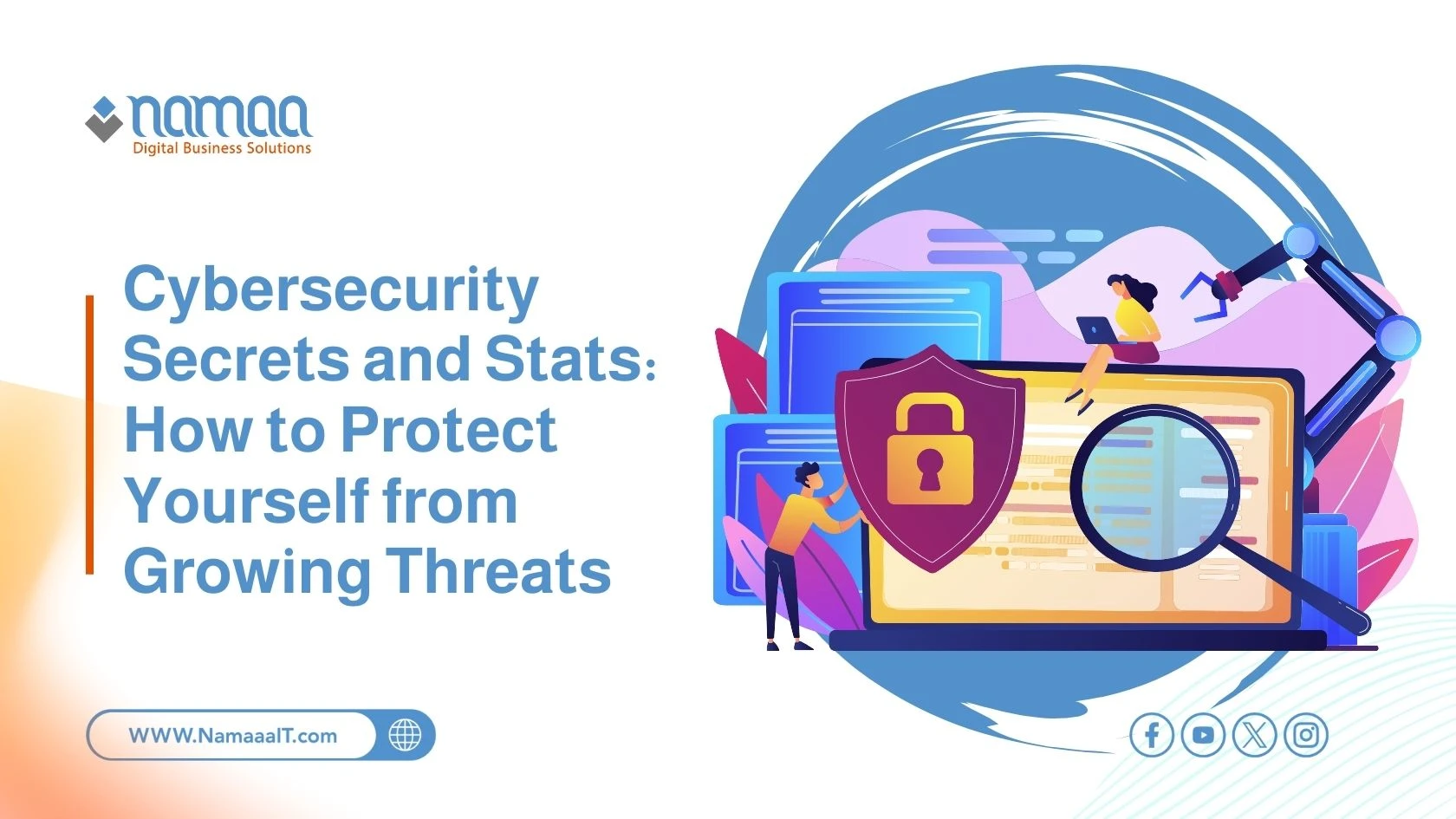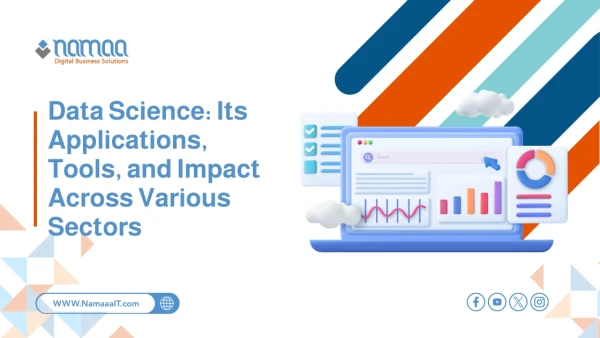Cybersecurity has become the cornerstone of protecting information and systems from growing threats. Statistics show that 85% of cybersecurity breaches are due to human error, highlighting the importance of awareness and continuous training. Reports also reveal that the cost of ransomware attacks may exceed $265 billion over the next decade, underscoring the significant financial impact of such attacks.
Attack methods vary, ranging from malware—detected at a rate of 360,000 files daily—to those targeting critical infrastructure. In this context, Artificial Intelligence (AI) is emerging as an effective tool for early threat detection. The UAE, for example, has succeeded in thwarting millions of attacks thanks to AI.
This article explores the insights and statistics behind cybersecurity, uncovering the threats, prevention strategies, and the latest technologies used in this field, aiming to enhance awareness for both individuals and organizations.
The Importance of Cybersecurity
Cybersecurity is now crucial for protecting data and systems from growing cyber threats. With increasing reliance on the internet across all sectors—governmental, commercial, and educational—it has become essential to safeguard information and prevent breaches that may impact personal or institutional security. Cyberattacks are constant threats to privacy and sensitive information, making it imperative for institutions and governments to develop effective cybersecurity strategies.
The importance of cybersecurity lies in the ability of companies to maintain the confidentiality of their customers' data and protect it from theft or manipulation. It also creates a safe environment for individuals to share sensitive information online without the fear of being hacked. Although security technologies are constantly evolving, the need for vigilance increases, especially with the emergence of new attack techniques. Thus, investing in cybersecurity is no longer optional—it’s a critical necessity for business continuity and protection against rising threats.
Moreover, having a strong cybersecurity system enhances the organization’s reputation and customer trust. It also protects sensitive systems like banking infrastructures, which heavily rely on the internet for financial transactions. Ultimately, cybersecurity is the frontline defense that protects the digital world from potential dangers and empowers individuals and organizations to interact freely without fear of exploitation or attacks.
read more: AI Applications in Operations Management
Cyber Threats in 2025
With increased reliance on technology and evolving cyberattack tools, experts predict that cyber threats in 2025 will become more sophisticated in nature and execution. Among these threats are ransomware attacks, which have become more complex and widespread. In such attacks, hackers encrypt victims’ data and demand a ransom to release it, putting businesses, hospitals, and government bodies at risk of significant financial losses and data loss. These attacks are expected to heavily impact critical sectors like healthcare and finance, which are data-dependent.
On another front, experts anticipate a rise in attacks targeting critical infrastructure, such as power plants and public utilities. Hackers increasingly aim to disrupt essential operations and cause large-scale disturbances. For instance, some countries have already experienced blackouts due to cyberattacks on their electrical grids. In 2025, this threat may grow with the advancement of attack techniques that exploit vulnerabilities in smart operating systems.
Another major concern is the use of Artificial Intelligence by attackers to launch more targeted and complex assaults. AI can analyze data faster and more accurately, allowing hackers to identify system vulnerabilities quickly. As AI technology evolves, it can be weaponized to launch sophisticated attacks against major institutions, making them harder to detect and defend against. These trends demand that organizations prepare for increasingly complex threats in the near future.
How Do Organizations Protect Their Data from Cyberattacks?
To protect their data, organizations must adopt a comprehensive security strategy based on a combination of practices and technologies that prevent breaches and reduce attack risks. First and foremost, institutions should install firewalls and use encryption technologies to safeguard data during transmission and storage. Encryption transforms data into an unreadable format unless accessed by authorized parties, ensuring the confidentiality of sensitive information. It's also essential to implement early threat detection systems, such as Intrusion Detection Systems (IDS), which can identify attacks in their early stages.
In addition, Identity and Access Management (IAM) is crucial for securing data by controlling who has access to sensitive information within the organization. Using strong passwords and enabling Two-Factor Authentication (2FA) can significantly reduce the chances of password-based breaches. Regular employee training is also critical to minimize human errors—one of the main causes of cyber incidents.
Another key aspect is regular system updates, which fix security vulnerabilities discovered in older versions. Continuous system monitoring is also essential to detect abnormal activities that may indicate a breach. In the event of a cyberattack, organizations should have a well-prepared incident response plan, including swift analysis and recovery measures.
Malware and Viruses: Hidden Threats and How to Fight Them
Malware, including viruses, are programs designed to harm computers, steal data, or disrupt systems. They typically enter systems via malicious links or email attachments containing harmful code. Some viruses replicate and spread across networks or external storage devices, posing an ongoing threat. Types of malware include:
File viruses that destroy files
Worms that consume system resources
Trojans that disguise malicious intent behind legitimate interfaces
To combat malware, organizations should use modern and regularly updated antivirus software, which scans systems to ensure they're free from threats.
Users must also follow personal protection practices, such as avoiding unknown links or attachments that may contain malware. Regular system updates are vital, as they often include security patches to fix exploitable vulnerabilities. Technologies like sandboxing can isolate potentially harmful programs, preventing them from affecting the actual system. Moreover, training users to recognize suspicious emails and phishing attempts is an effective defense.
Regular data backups are another essential measure. If data is encrypted or destroyed by malware, backups allow for recovery without significant business disruption. Overall, effective malware defense requires a mix of technical tools, preventive measures, and continuous awareness.
The Role of Artificial Intelligence in Enhancing Cybersecurity
Artificial Intelligence (AI) plays a pivotal role in strengthening cybersecurity in the modern world. Thanks to its ability to process and analyze vast amounts of data at lightning speed, AI has become an indispensable tool in detecting and responding to threats proactively. AI helps identify unusual patterns in networks or computer systems, enabling it to detect potential attacks before they happen—a concept known as proactive security. Through machine learning, AI can analyze user behavior to flag abnormal activities that may signal a breach attempt.
Moreover, AI can enhance incident investigation processes. It can examine and analyze attacks post-event to identify their scale, cause, and methods used. AI can also react quickly by taking automated corrective actions, such as isolating compromised systems to prevent further damage.
Another application of artificial intelligence in cybersecurity is the detection of malicious software such as viruses, worms, and Trojans. Through software behavior analysis techniques, AI can distinguish between normal patterns and threats, making it easier to detect new threats—even those that haven’t been seen before. In the future, AI is expected to become a cornerstone in enhancing institutions’ capabilities to combat complex and evolving threats, by making security operations more precise and faster.
Cybersecurity: Hidden Facts and Figures
By 2025, cybersecurity has become more complex and critical than ever, with projections suggesting that the cost of cybercrimes will reach $10.5 trillion annually, and could rise to $15.63 trillion by 2029. Ransomware attacks continue to top the list of threats, leveraging artificial intelligence and advanced social engineering techniques to expand their reach and increase their impact. Additionally, 79% of threat detections were malware-free, indicating a growing use of attack techniques that do not rely on traditional malware.
Cyber threats are also increasing amid geopolitical tensions, as cyberattacks have become tools used by nations for espionage, disrupting critical infrastructure, or even affecting the economies of adversaries. According to a report by the World Economic Forum, 60% of organizations had to adjust their cybersecurity strategies due to these escalating tensions—highlighting the need for more resilient and adaptive defense strategies in an unstable environment.
In this context, artificial intelligence emerges as a pivotal factor—not only in enhancing defense mechanisms but also in escalating the level of threats, creating a continuous race between attackers and defenders. This shifting environment calls for the adoption of advanced and integrated security strategies to confront increasingly complex and evolving threats.
Future Trend Analysis in Cybersecurity
The cybersecurity world is expected to undergo significant transformations in the coming years. With the growing reliance on digital technology, cyberattacks will become more sophisticated than ever. Companies are turning to AI and machine learning to analyze user behavior and detect threats before they occur. These technologies won’t just identify anomalies but will also improve cybersecurity strategies by predicting and analyzing attacks faster and more accurately. AI will also enhance the ability of security teams to process massive volumes of data in less time, enabling faster response times in a rapidly changing business environment.
One of the key future trends in cybersecurity is the growing integration of cybersecurity technologies with cloud computing. As more organizations move to the cloud for data storage and application operations, the need for robust data protection mechanisms in cloud environments becomes more critical. This necessitates the improvement of security frameworks that manage sensitive customer data and information. As a result, new protection solutions are expected to emerge to defend against cloud-targeted threats such as unauthorized access attacks.
Despite the rapid development of defensive tools, cyberattacks will continue to grow due to advanced attack techniques like AI-powered malware. Responding to these threats will require more precise and specialized solutions through automated systems that focus on reducing the time between attack and response. These technologies will encourage businesses to adopt more proactive cybersecurity strategies to mitigate rising risks.
Encryption Technologies and Their Importance in Data Protection
Encryption is one of the core technologies used to protect data in the world of cybersecurity. It is the process of converting data into an unreadable format that can only be decoded using a special decryption key. This technique acts as the first line of defense against breaches, protecting information from unauthorized access while it is being transmitted online or stored on devices. The importance of encryption has increased with the growing volume of data being sent over the internet, especially with technologies like cloud computing now commonly used to store sensitive information online. In this context, using advanced and strong encryption systems is essential to safeguard data from theft or tampering.
Encryption technologies vary depending on needs and use cases. For example, symmetric encryption uses the same key for both encryption and decryption, while asymmetric encryption uses two different keys. While symmetric encryption is faster and more efficient, asymmetric encryption provides a higher level of security. In communications, protocols like HTTPS and SSL/TLS are used to encrypt data transmitted between users and servers, preventing it from being intercepted by hackers.
On another front, encryption is especially vital in dealing with increasing threats like ransomware attacks, where hackers encrypt victims’ data and demand a ransom for decryption. Thus, encryption is a fundamental part of security strategies—not only to secure data in transit but also to protect backups and data stored on various devices. In this way, encryption helps reduce the risks associated with cyberattacks and preserves the confidentiality of information in the online environment.
How to Detect Cyberattacks Before They Happen
Detecting cyberattacks before they occur is one of the main challenges facing cybersecurity professionals. Fortunately, several techniques and tools are being developed to enable early detection. One commonly used method is network behavior analysis, using AI and machine learning to monitor abnormal patterns in data traffic. These technologies involve observing the behavior of users and devices, and processing this information to identify suspicious actions that may indicate an attempt to breach or attack the system. For example, an unusual spike in data traffic or multiple attempts to access encrypted files might signal abnormal activity.
Modern security systems also rely on deep learning to identify threats at early stages. These systems analyze large volumes of data to understand normal patterns within a system, and once any deviation is detected, they alert security teams. This method saves valuable time and helps classify threats more quickly than traditional techniques.
Additionally, modern technologies rely on security frameworks like Intrusion Detection Systems (IDS), which monitor network traffic and look for any unauthorized activity. Proactive threat detection techniques, such as behavioral protection through continuous monitoring of security systems, are also used to detect hacking attempts in real time. By collecting and analyzing data promptly, organizations can respond to threats before they affect the entire system.
Summary
✅ Cybercrime costs are expected to reach $10.5 trillion annually by 2025, possibly increasing to $15.63 trillion by 2029.
✅ Ransomware attacks are among the top threats, leveraging advanced AI and social engineering techniques.
✅ 79% of threat detections were malware-free, indicating the use of new non-traditional attack methods.
✅ 60% of organizations had to adjust their cybersecurity strategies due to rising geopolitical tensions, highlighting the need for adaptive defense strategies.
✅ AI is used to detect anomalies and analyze user behavior faster and more accurately than traditional methods.
✅ Encryption is crucial for data protection during transmission and storage, relying on technologies like HTTPS and SSL/TLS.
✅ Asymmetric encryption provides a higher level of security compared to symmetric encryption.
 Home
Let's think together
Articles
About
Contact Us
عربي
عربي
Home
Let's think together
Articles
About
Contact Us
عربي
عربي




.webp)


 A Complete Guide to Increasing User Reach (2).webp)
